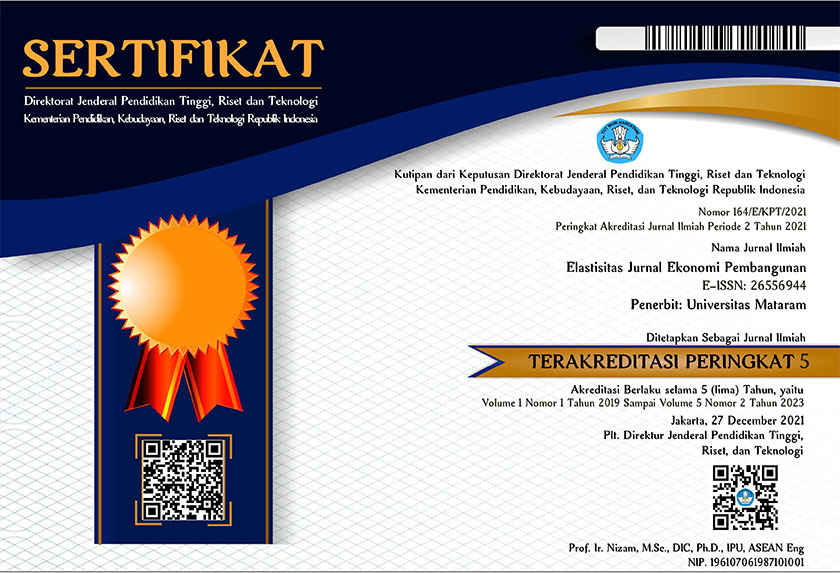Penggunaan Aplikasi Mobile Banking Pada Bank Konvensional dan Bank Syariah di Nusa Tenggara Barat: Pembuktian Model Unified Theory of Acceptance and Use of Technology (UTAUT)
Keywords:
m-banking, unified theory of acceptance and use of technology (UTAUT), niat berperilaku, perilaku menggunakanAbstract
Beberapa strategi ditempuh perbankan untuk meningkatkan kualitas dan ragam layanan keuangan, dimana sejumlah bank mengembangkan digital banking secara internal (in house) yang berfokus pada multichannel delivery terutama m-banking, sehingga fungsi layanan bank menjadi lebih efisien. Salah satu konstruksi model yang kiranya dapat membuktikan penerimaan dan penggunaan teknologi m-banking adalah model unified theory of acceptance and use of technology (UTAUT). Tujuan penelitian ini adalah untuk membuktikan bahwa harapan kinerja, harapan berusaha, pengaruh sosial, kondisi fasilitas, jenis kelamin, dan usia berpengaruh langsung dan signifikan terhadap niat berperilaku menggunakan m-banking, serta untuk membuktikan bahwa niat berperilaku berpengaruh positif dan signifikan terhadap perilaku menggunakan m-banking.
Lokasi penelitian di 2 Kota dan 8 Kabupaten di Provinsi Nusa Tengara Barat. Metode pengumpulan data menggunakan sampel survey, dengan jumlah sampel sebanyak 100 nasabah pengguna m-banking. Teknik sampling menggunakan metode judgement sampling, adapun alat pengumpulan data menggunakan kuesioner memanfaatkan aplikasi google form. Pengujian hipotesis menggunakan alat analisis SEM-PLS.
Hasil penelitian membuktikan bahwa bahwa dari 4 variabel yakni harapan kinerja, harapan usaha, dukungan sosial, dan kondisi fasilitas, hanya harapan usaha yang tidak berpengaruh signifikan, sedangkan harapan kinerja, dukungan sosial, dan kondisi fasilitas berpengaruh signifikan terhadap niat berperilaku menggunakan m-banking. Efek moderasi jenis kelamin dan usia tidak berpengaruh terhadap niat berperilaku dan perilaku menggunakan m-banking. Adapun niat berperilaku berpengaruh signifikan terhadap perilaku menggunakan m-banking pada bank konvensional dan bank syariah di Provinsi NTB. Perilaku menggunakan m-banking dapat diukur melalui niat dan dianggap sebagai variabel penting dalam penerimaan teknologi, hal tersebut secara eksplisit diungkapkan bahwa niat perilaku sebenarnya mengarah pada penggunaan teknologi.
References
Alalwan, A.A., Dwivedi, Y.K. and Rana, N.P. (2017), “Factors influencing adoption of mobile banking by Jordanian bank customers: extending UTAUT2 with trustâ€, International Journal ofInformation Managment, Vol. 37 No. 3, pp. 99-110.
Alalwan, A.A., Dwivedi, Y., Rana, N.P. and Williams, M.D. (2016), “Consumer adoption of mobile banking in Jordan: examining the role of usefulness, ease of use, perceived risk and self-efficacyâ€, Journal of Enterprise Information Management, Vol. 29 No. 1.
Alalwan, A.A., Dwivedi, Y.K., Rana, N.P., Lal, B. and Williams, M.D. (2015), “Consumer adoption of Internet banking in Jordan: examining the role of hedonic motivation, habit, self-efficacy and trustâ€, Journal of Financial Services Marketing, Vol. 20 No. 2, pp. 145-157.
Al-Jabri, I.M. and Sohail, M.S. (2012), “Mobile banking adoption: application of diffusion of innovation theoryâ€, Journal of Electronic Commerce Research, Vol. 13 No. 4, pp. 379-391.
Al-Somali, S.A., Gholami, R. and Clegg, B. (2009), “An investigation into the acceptance of online banking in Saudi Arabiaâ€, Technovation, Vol. 29 No. 2, pp. 130-141.
Awwad, M.S. and Ghadi, M.Y. (2010), “Investigation of factors influencing the intention to adopt mobile banking services in Jordanâ€, Dirasat: Administrative Sciences, Vol. 37 No. 2,
Baptista, G. and Oliveira, T. (2015), “Understanding mobile banking: the unified theory of acceptance and use of technology combined with cultural moderatorsâ€, Computers in Human Behavior, Vol. 50, pp. 418-430.
Deameta, Armelia Firana. 2019. Prediksi Intensi Perilaku Terhadap Penggunaan Mobile Banking Menggunakan The Unified Theory of Acceptance and Use of Technology, Trust, dan Network Externalities (Studi Pada Penggunaan Mobile Banking di Kota Bandung). JASa (Jurnal Akuntansi, Audit dan Sistem Informasi Akuntansi ) Vol. 3 No. 2 /Agustus 2019 ISSN 2550-0732 print / ISSN 2655-8319 online.
Gu, J.C., Lee, S.C. and Suh, Y.H. (2009), “Determinants of behavioral intention to mobile bankingâ€, Expert Systems with Applications, Vol. 36 No. 9, pp. 11605-11616.
Hanafizadeh, P., Behboudi, M., Koshksaray, A.A. and Tabar, M.J.S. (2014), “Mobile-banking adoption by Iranian bank clientsâ€, Telematics and Informatics, Vol. 31 No. 1, pp. 62-78.
Howell, J. and Wei, J. (2010), “Value increasing model in commercial e-bankingâ€, Journal of Computer Information Systems, Vol. 51 No. 1, pp. 72-81, available at: www.sbp.org.pk/ibd/bulletin/2016/Sep.pdf, www.sbp.org.pk/reports/annual/arFY15/Vol1/Chapter-2.pdf
Jose, Ambily, G.S. Gireesh Kumar, Roshna Varghese. 2017. Factors Influencing Customer Adoption of Mobile Banking Services With Special Reference To Ernakulam District. IOSR Journal of Business and Management (IOSR-JBM) e-ISSN: 2278-487X, p-ISSN: 2319-7668. Volume 19, Issue 11. Ver. VII (November. 2017), PP 41-47. www.iosrjournals.org
Khan, M. and Bhatti, M. (2008), Developments in Islamic Banking: The Case of Pakistan, Springer.
Khan, M.K., Zhang, J. and Wang, X. (2008), “Chaotic hash-based fingerprint biometric remote user authentication scheme on mobile devicesâ€, Chaos, Solitons and Fractals, Vol. 35 No. 3, pp. 519-524.
Kim, G., Shin, B. and Lee, H.G. (2009), “Understanding dynamics between initial trust and usage intentions of mobile bankingâ€, Information Systems Journal, Vol. 19 No. 3, pp. 283-311.
Lin, H.F. (2011), “An empirical investigation of mobile banking adoption: the effect of innovation attributes and knowledge-based trustâ€, International Journal of Information Management, Vol. 31 No. 3, pp. 252-260.
Luarn, P. and Lin, H.H. (2005), “Toward an understanding of the behavioral intention to use mobile bankingâ€, Computers in Human Behavior, Vol. 21 No. 6, pp. 873-891.
Lu, H.P. and Yu-Jen Su, P. (2009), “Factors affecting purchase intention on mobile shopping web sitesâ€, Internet Research, Vol. 19 No. 4, pp. 442-458.
Lu, M.T., Tzeng, G.H., Cheng, H. and Hsu, C.C. (2015), “Exploring mobile banking services for user behavior in intention adoption: using new hybrid MADM modelâ€, Service Business, Vol. 9 No. 3, pp. 541-565.
Mahfuz, Mohammad Abdullah, Liza Khanam, Wang Hu. 2016. The Influence of Culture on M-Banking Technology Adoption: An Integrative Approaches of UTAUT2 and ITM. 2016 Proceedings of PICMET '16: Technology Management for Social Innovation.
Mishra, V. and Bisht, S.S. (2013), “Mobile banking in a developing economy: a customer-centric model for policy formulationâ€, Telecommunications Policy, Vol. 37 Nos 6/7, pp. 503-514.
Mohammadi, H. (2015), “A study of mobile banking loyalty in Iranâ€, Computers in Human Behavior, Vol. 44, pp. 35-47.
Oliveira, T., Faria, M., Thomas, M.A. and Popovic, A. (2014), “Extending the understanding of mobile banking adoption: when UTAUT meets TTF and ITMâ€, International Journal of InformationManagement, Vol. 34 No. 5, pp. 689-703.
Raza, S.A. and Hanif, N. (2013), “Factors affecting internet banking adoption among internal and external customers: a case of Pakistanâ€, International Journal of Electronic Finance, Vol. 7 No. 1, pp. 82-96.
Raza, S.A., Qazi, W. and Shah, N. (2018), “Factors affecting the motivation and intention to become an entrepreneur among business university studentsâ€, International Journal of Knowledge andLearning, Vol. 12 No. 3, pp. 221-241.
Raza, Syed Ali, Nida Shah, Muhammad Ali. (2018). "Acceptance of mobile banking in Islamic banks: evidence from modified UTAUT model", Journal of Islamic Marketing.
Siyal, Abdul Waheed, Waheed Ali Umrani, and Shaharbano Bhand. 2019. Predicting Mobile Banking Acceptance and Loyalty in Chinese Bank Customers. SAGE Open April-June 2019: 1–21© The Author(s) 2019.DOI: 10.1177/2158244019844084. Journals.sagepub.com/home/sgo
Tam, Carlos and Tiago Oliveira. 2017. Understanding mobile banking individual performance The DeLone & Mc Lean model and the moderating effects of individual culture. Internet Research Vol. 27 No. 3, 2017 pp. 538-562. © Emerald Publishing Limited 1066-2243. DOI 10.1108/IntR-05-2016-0117
Teo, A.C., Tan, G.W.H., Cheah, C.M., Ooi, K.B. and Yew, K.T. (2012), “Can the demographic and subjective norms influence the adoption of mobile banking?â€, International Journal of MobileCommunications, Vol. 10 No. 6, pp. 578-597.
Tsai, W.-H., Lee, P.-L., Shen, Y.-S. and Lin, H.-L. (2012), “A comprehensive study of the relationship between enterprise resource planning selection criteria and enterprise resource planning system successâ€, Information & Management, Vol. 49 No. 1, pp. 36-46.
Tun, Phyo Min. 2019. A Conceptual Framework on Intention to Use Mobile Banking Service of Private Banks: A Myanmar Perspective. Conference: Proceedings of the 17th International Conference on Computer Applications 2019. At : Yangon, Myanmar.
https://www.researchgate.net/publication/331408467
Venkatesh, V., Thong, J.Y. and Xu, X. (2012), “Consumer acceptance and use of information technology: extending the unified theory of acceptance and use of technologyâ€, MIS Quarterly, Vol. 36 No. 1, pp. 157-178.
Venkatesh, V., Morris, M.G., Davis, G.B. and Davis, F.D. (2003), “User acceptance of information technology: toward a unified viewâ€, MIS Quarterly, pp. 425-478.
Wang, L. and Yi, Y. (2012), “The impact of use context on mobile payment acceptance: an empirical study in Chinaâ€, in Advances in Computer Science and Education, Springer, Berlin, Heidelberg, pp. 293-299.
Wang, Hsiu-Yuan, and Shwu-Huey Wang. 2010. User Acceptance of Mobile Internet Based on The Unified Theory of Acceptance And Use of Technology: Investigating The Determinants and Gender Differences. Social Behavior And Personality, 2010, 38(3), 415-426. ©Society for Personality Research (Inc). DOI 10.2224/sbp.2010.38.3.415
Wang, W.-T. and Li, H.-M. (2012), “Factors influencing mobile services adoption: a brand-equity perspectiveâ€, Internet Research, Vol. 22 No. 2, pp. 142-179.
Williams, Michael D., Nripendra P. Rana and Yogesh K. Dwivedi. 2015. The unified theory of acceptance and use of technology (UTAUT): a literature review. Journal of Enterprise Information Management. Vol. 28 No. 3, 2015. pp. 443-488 © Emerald Group Publishing Limited 1741-0398. DOI 10.1108/JEIM-09-2014-0088
Wonglimpiyarat, J. (2014), “Competition and challenges of mobile banking: a systematic review of major bank models in the Thai banking industryâ€, The Journal of High Technology ManagementResearch, Vol. 25 No. 2, pp. 123-131.
Zalloum, Lama, Hamad Alghadeer, Nawras Nusairat. 2019. The Effect of Using Mobile Banking Services Applications on Electronic Word of Mouth: The Mediating Role of Perceived Trust. International Business Research; Vol. 12, No. 9; 2019. ISSN 1913-9004. E-ISSN 1913-9012. Published by Canadian Center of Science and Education
Zhou, T., Lu, Y. and Wang, B. (2010), “Integrating TTF and UTAUT to explain mobile banking user adoptionâ€, Computers in Human Behavior, Vol. 26 No. 4, pp. 760-767.






